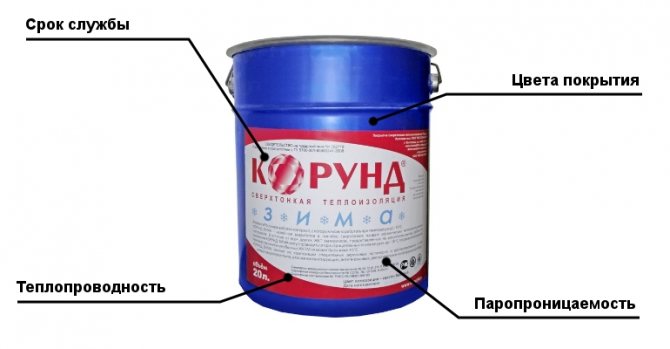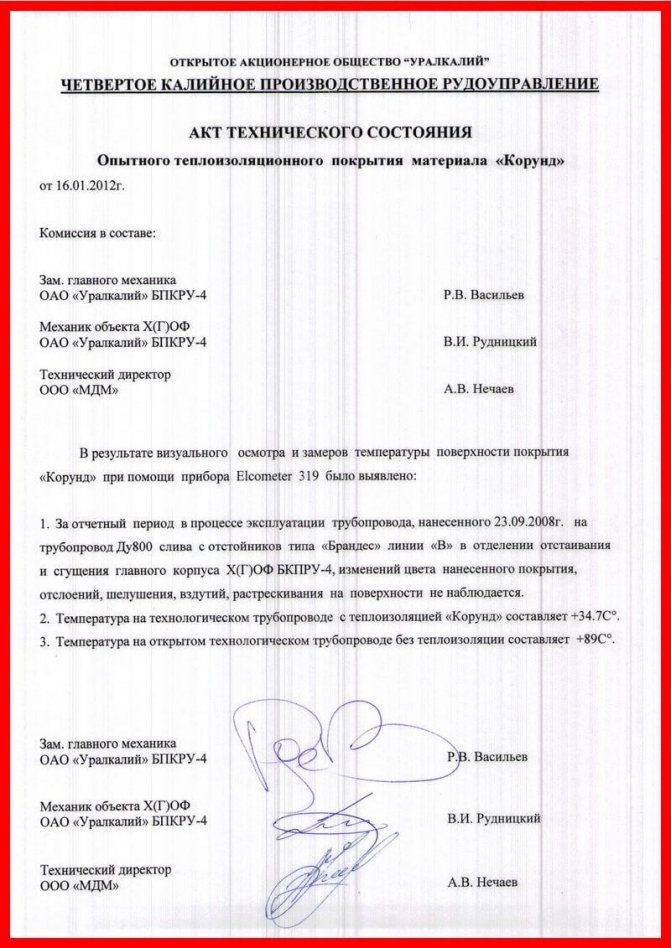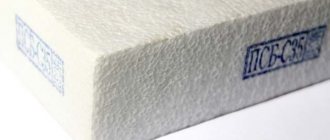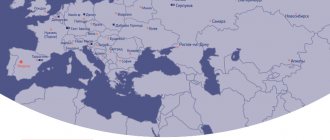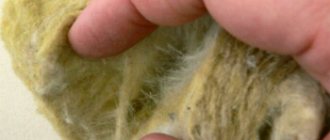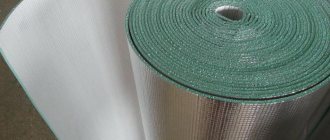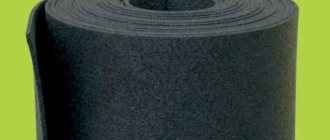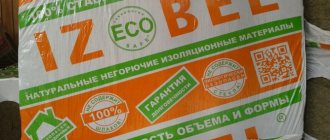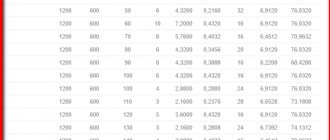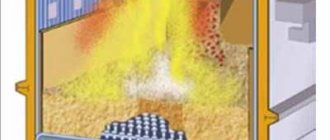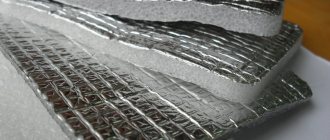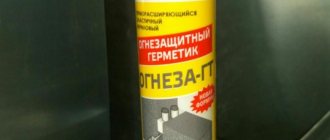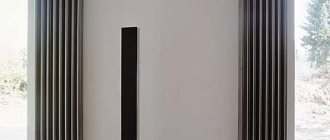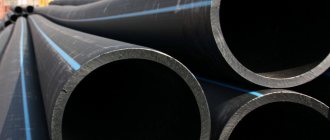The retention of heat inside the room largely depends on the thermal insulation parameters of the structure itself and the finishing materials used. Insulating a house reliably means reducing heating costs. Today, the construction industry offers many varieties of insulation materials, which vary in their characteristics and cost. One of the most optimal options is Korund liquid thermal insulation, which is distinguished by its durability and excellent thermal insulation properties. Let us consider in more detail the features of the composition, selection criteria and application technique.
Features of ceramic heat paint
The unique composition of thermal insulation is also called heat-reflecting paint, since with a layer thickness of only 1 mm it can have a noticeable energy-saving effect. Due to this, thermal insulation of Korund is very economical in terms of consumption. The filler contains microscopic hollow spheres - ceramic, polymer, composite, glass balls, which are filled with rarefied air. Such microparticles can vary not only in composition, but also in the size of microgranules, percentage, homogeneity of components, etc.
Externally, the ceramic superfine paint is practically indistinguishable from ordinary acrylic-based paint. Despite the fact that today the construction market offers several varieties of ultra-thin insulating compositions, almost all of them have a similar structure:
- Warm paint is based on water-acrylic solution. Its properties make it possible to ensure uniform distribution of heat-insulating components over the working surface. In addition, the composition contributes to a better fixation of liquid ceramics.
- Also, the binder contains various kinds of additives that improve the performance parameters of the heat paint. The most common material additives include natural and artificial rubbers, silicone, etc.
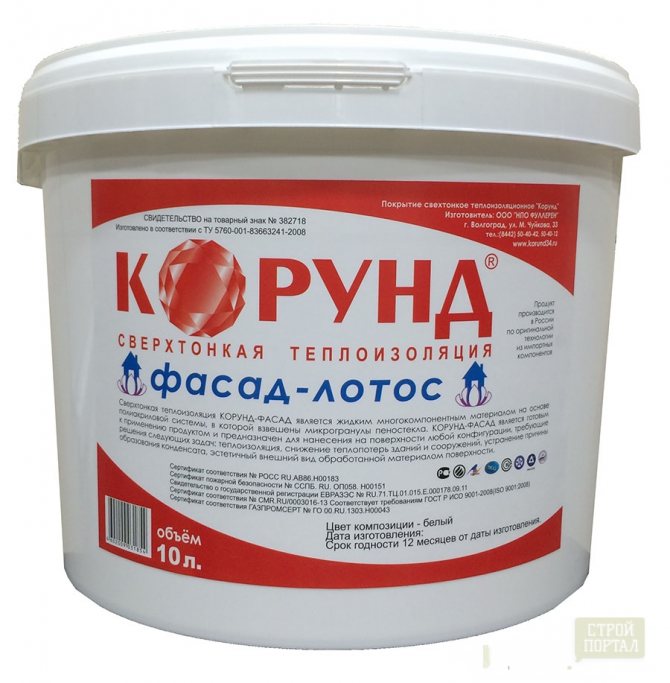
Features of production and general description
Thermal insulation Corundum is a composition based on ceramic microspheres and an acrylic binder. The last ingredient is produced using catalysts and fixatives.
The size of the microspheres varies from 0.01 to 0.5 mm. The composition of the product is also supplemented with all kinds of additives to enhance the performance properties. Such a composition gives the material flexibility, lightness and elasticity. In addition, Corundum is characterized by good adhesion to a wide variety of surfaces.
The consistency of this brand of heat insulator resembles ordinary paint. In fact, it is a white suspension, which, after curing, forms a very reliable and flexible polymer coating.
Compared with ordinary heat insulating materials, Korund provides not only protection against heat loss, but also against corrosion.
Initially, such coatings with heat-shielding properties were created at the request of NASA for finishing spacecraft. For some time, specialists have adapted these mixtures for "earthly" needs. Corundum is the commercial name of a product that was developed by Russian specialists. This heat insulator has special certificates that attest to its high quality.
Liquid thermal insulation Korund: technical characteristics and principle of operation
The temperature range for thermal paint varies from -65 ° C to + 260 ° C.The main technical characteristics are vapor permeability and hygroscopicity of liquid insulation, which can be applied to almost any type of facade material: concrete, stone, brick, metal, plastic, etc.
This material guarantees the removal of condensation that forms on the walls and pipes in the room. The composition of such a warm paint includes special fixatives, catalysts, anti-corrosion additives, as well as a binder base on high-strength acrylic. Along with the content of microspheres, this composition is easy to apply and spread over the entire surface, providing good indicators of energy saving and thermal insulation.
An important argument to buy Korund liquid thermal insulation is the safety of the substance. Due to the content of natural additives and environmentally friendly components, the treated surface is non-toxic and does not emit any odors. This allows the use of heat paint for insulation of any premises. It is possible to create a stable thermal barrier even in children's rooms or dwellings where allergy sufferers are located.
The thermal insulation properties of the composition can be achieved in several ways:
- By convection, i.e. heat transfer by the heat paint layer itself. Due to the fact that most of the specific gravity of the liquid insulation consists of hollow balls, the losses due to convection in the composition are quite insignificant.
- The thermal conductivity of a material, when heat is transferred from a warmer part of a surface to a colder place. In liquid insulation, only 20% of the binder has thermal conductivity properties.
- Radiation is a phenomenon in which heat transfer occurs through the internal energy of the suspension. In energy-saving paint, microscopic spheres are endowed with reflection and heat dissipation properties. Almost 90% of the reflected radiation turns the working surface of the wall into an analogue of a thermos.


Advantages and disadvantages of Corundum
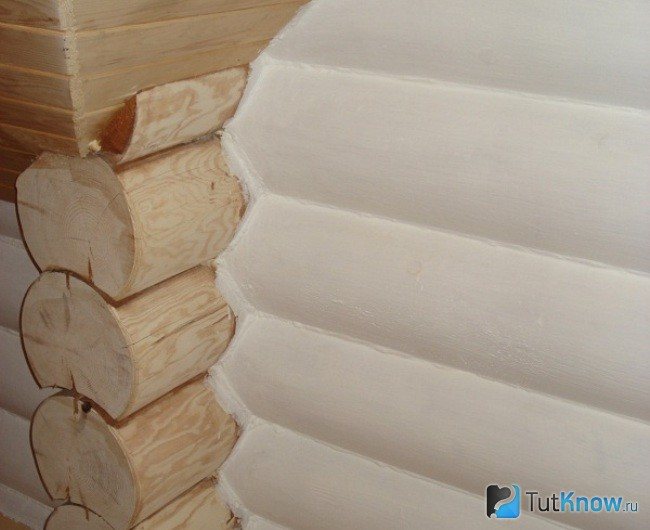

The heat insulator is able to completely fill the micropores of the treated surface. In this case, the concentration of the polymerized material is 80%. In addition, Korund coating thermal insulation has the following advantages:
- Excellent heat retention
... One millimeter of heat-saving paint is comparable in efficiency to 50 millimeters of roll insulation, for example, mineral wool. - Ease of application
... Corundum is applied like a regular paint with standard tools: brush, roller, spray gun. It does not emit harmful substances and therefore does not require respiratory protection. - Protects surfaces from destruction
... Metal coated with Corundum will not rust, wood will not rot and dry out under the influence of atmospheric agents, plaster, brick, concrete will crumble and crack. - Does not attract microorganisms, insects, rodents
... The surfaces covered with this insulation will not rot or mold. - Lightness of the insulation layer
... The weight of the Korund insulation is incomparable with the traditional roll coating. Such insulation will not exert any load on the load-bearing walls and foundation. Therefore, liquid ceramic insulation can be applied even to unstable and fragile structures. - No seams and cold bridges
... Corundum allows you to create a durable seamless coating through which cold cannot penetrate into the room. - Environmentally friendly and durable
... Throughout the entire service life, the material does not emit any harmful substances. Therefore, it can be safely used to insulate residential buildings, as well as houses where allergy sufferers live. - Does not affect the geometry of the room
... Unlike bulky traditional thermal insulation, Corundum will not affect the size and shape of the building in any way. - Can serve as an independent finishing layer
... Pigments can be added to the thermal paint, which allows it to be used for wall decoration without additional decorative coatings.
This liquid ceramic insulation also has certain disadvantages. First of all, this is a relatively high price. Corundum appeared on the domestic market not so long ago, so for now its cost is quite high. However, this drawback is leveled by the fact that the thermal paint is characterized by a long service life and perfectly retains heat.
Also among the disadvantages is the rapid solidification of the material. Therefore, you need to work with him promptly.
Advantages of thermal insulation Korund
Liquid heat-saving paint is an innovative composition that differs from all existing coatings. Among the most significant advantages of its use, it is necessary to highlight the following aspects:
- The universality of the substance. It can be applied to any kind of surface, including untreated, if it is indicated on the instructions for use. Specialists use heat paint for processing brick, concrete, metal, plastic surfaces, as well as for thermal insulation of equipment and air ducts.
- Wear resistance. The applied layer of liquid insulation does not degrade over time. Corundum provides a guaranteed service life of up to 15 years, and with proper care (timely cleaning, high-quality finishing), this indicator can be doubled.
- Ceramic thermal insulation has good adhesion to any type of material, which provides good protection against moisture and air ingress.
- The substance is resistant to an alkaline environment.
- Liquid thermal insulation provides anti-corrosion protection and minimizes heat loss.
- Dry coating with heat paint reliably protects the treated surface from deformation due to temperature extremes, atmospheric influences and the formation of moisture.
- Ceramic insulation is practical and easy to apply to complex geometric surfaces.
- The material is ultra-light, so there is no additional load on the structure. Due to this property, heat paint is often used in roofing.
- The substance is quite convenient to repair, because in case of minor damage, the old layer can be easily removed by replacing it with a new one.
- Heat paint reflects up to 80% of the energy of ultraviolet rays.
- In addition, liquid insulation is resistant to fire. When heated to + 260 ° C, the applied layer is carbonized, and when it reaches + 600 ° C, the heat paint begins to decompose, releasing carbon and nitrogen oxide, which prevents the rapid spread of flame.
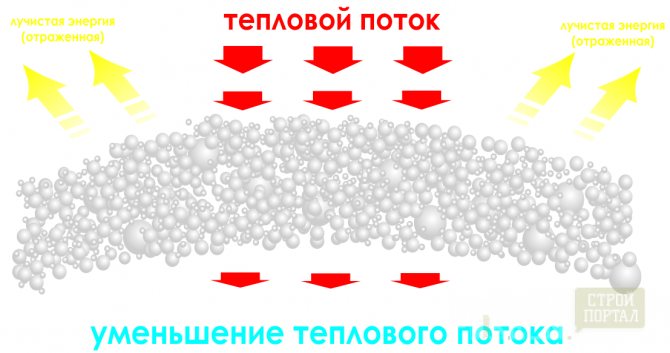

Major manufacturers of thermal paints
"Corundum"
Paints for thermal insulation are now becoming more widespread due to their positive characteristics, therefore they are on sale in almost all specialized stores. Some manufacturers are well established and their products are used quite often. Let's consider the most famous of them.
Heat-insulating paint "Korund" represents a wide range of heat mixtures for various areas. The products are used for cooling boilers, steam lines and heating systems. To reduce heat loss, the mixture is used for outdoor work. Indoors, it can perform two functions - both heat-insulating and decorative. It is often used for interior decoration of public spaces. Suitable for works carried out in bathrooms, as due to its properties it copes with mold and mildew, in addition, it is water resistant.
Available in 4 types.
- "Korund Classic". It is used both for external and internal work. Withstands temperatures from -60 to +250 degrees Celsius.
- "Korund Antikor"... It is used when working with metal products. Protects against corrosion.
- "Corundum Winter". It makes it possible to apply paint in the winter season at temperatures up to -10 degrees.It is mainly used for outdoor work.
- "Korund Facade"... It is used for thermal insulation of facades. Well protects the surface from moisture. When applying, remember that the thickness of each layer should not be less than 1 millimeter.
"Astratek"
Thermal insulating paint "Astratek" is considered environmentally friendly, since it does not contain organic solvents. Its protective layer is up to 3 millimeters thick. The service life is 15-30 years. Suitable for thermal insulation of various surfaces, including the most difficult to access, with temperatures up to 150 degrees.
Available in 3 types.
- Astratek Universal. It is used for work both indoors and outdoors. Made in white and gray. If necessary, the mixture can be diluted with water. Withstands temperatures from -60 to +260 degrees.
- "Astratek Metal"... Gray heat paint with anti-corrosion effect. Used when working with metal, suitable for external and internal work.
- "Astratek Facade". Used when working with building facades. Has a water-repellent effect. White color. Easy to apply due to its viscosity.
"Armor"
Heat-insulating paint "Bronya" is actually a liquid ceramic coating. It is used for both interior and facade work. Ideal for insulating pipes and large liquid tanks. Used for painting equipment.
Available in 4 types.
- "Armor Classic"... Provides thermal insulation for pipelines and heating systems. Perfectly protects against external negative influences.
- "Bronya Antikor". It is used when working with metal products. Protects against rust.
- "Armor Winter"... It can be used in the cold season at temperatures down to -35 degrees. Frost-resistant during further exploitation.
- "Bronya Facade"... Provides thermal insulation for facades. It is applied in layers at least 1 millimeter thick. Protects against mold and mildew.
See below for an experiment to hold heat with paint.
Disadvantages of ultra-thin warm paint Corundum
Despite the impressive list of advantages of the material, it is not devoid of some disadvantages. Among them, the following aspects should be highlighted:
- The high cost of warm paint.
- Since ceramic insulation is a relatively new product in the construction market, there is still no time-tested evidence that the material meets the declared characteristics.
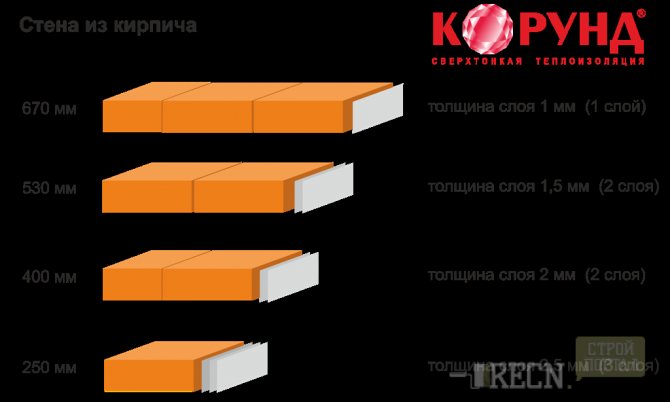

From May 05 to May 13, 2020, a joint Sino-South Korean delegation attended, bringing together both leading scientists from Seoul State University and successful entrepreneurs from China and South Korea. As part of a representative delegation, FULLEREN met Korean professors Lee Wu-Il, Park Byung-Kyo and Kim Min-Sum, as well as leaders and managers of FULLEREN's longtime partner in the Asian market - Mr. He Kwangjo, Ro Il-Sub and Xiao I. The program of stay included a number of events at the Volgograd State Technical University, acquaintance with production facilities, business meetings and negotiations, walks in the historical places of the hero-city of Volgograd.
During the business visit of the international delegation to the Volgograd State Technical University, the First Vice-Rector of Volgograd State Technical University Alexander V. Navrotsky talked with the guests, telling them about the current priority directions of development and organization of the educational process of the technical university.
After the official meeting, the professors and businessmen were invited to the Volgograd State Technical University Museum, where the head of the Science and Innovation Department, Professor Nikolai Alekseevich Kidalov introduced the guests to the history of the university's formation and presented them the university's scientific achievements in the field of chemistry, materials science, welding and foundry production, mechanical engineering, food production , economics and information technology. Polytechnic scientists have created elastomeric materials with unique properties for oil and gas production equipment, polymer coatings for sports purposes. They also work on polymer thermal insulation and waterproofing coatings, in particular, for construction needs.Structural fiberglass plastics and low-flammability polymers based on phosphorus-containing monomers created by polytechnics are used in shipbuilding. Progressive technological processes for the manufacture of metal layered composite materials using explosion welding, developed by the scientists of Volgograd State Technical University, have been implemented at a number of leading Russian and foreign enterprises of nuclear power engineering and petrochemical apparatus engineering.
Professor VolgSTU Doctor of Technical Sciences Nikolay Alekseevich Kidalov and Associate Professor, Ph.D. Aleksey Nikolayevich Gaidadin introduced the engineering center of the technical university to the guests - "Polymer composite materials and technologies". The center's field of activity: the development of polymer composite materials, the design of polymer products, the development of formulations and the production of products from thermoplastic elastomers, the introduction of innovations to the market. This area is a priority in the scientific work of Korean scientists, which served as an occasion for a fruitful discussion of the prospects for cooperation. Convinced of the significant similarity of scientific approaches, the parties plan to develop partnerships in three areas: training, joint research, technology acquisition.
Representatives of the international highly appreciated the quality of the products of FULLEREN Scientific and Production Association, noted the principled nature and goodwill of the existing partnership, outlined further ways of developing the distribution of thermal insulation materials of the KORUND series in South Korea and China.
I am grateful to my guests for the attentive and kind-hearted attitude and sincerely hopes for the further development of good-neighborly business contacts!
Link to news
The main types of thermal insulation
Liquid ultra-thin thermal insulation is presented in the sale of specialized hardware stores in several versions. The entire line of polymer compositions consists of the following types:
- Thermal insulation Korund Classic is a liquid suspension designed for roofing and facade works. Also, this composition has found application in the interior decoration of premises, providing reliable thermal insulation of walls in residential buildings and general buildings. In addition, the classic variety is highly effective for insulating concrete floors, self-leveling coatings, hot and cold water supply lines, as well as insulating window slopes.
- Corundum Anticorrosive is a special anti-corrosion compound that can be applied simply on a rusty surface, without any special treatment. Such a heat paint is distinguished by high adhesion rates to concrete and metal, creating a reliable protective and insulating layer. As a rule, this liquid thermal insulation Korund is slightly cheaper than the classical type and is used to create the first base layer of insulation.
- Facade is a type of heat-saving paint designed for the treatment of concrete surfaces, as well as buildings made of slag or foam blocks. The composition is applied in a thickened layer, thereby reducing the coefficient of labor costs for treating large surfaces. This type of warm paint is usually used for finishing.
- Winter - liquid thermal insulation designed for work in the cold season. The energy saving principle is based on the "thermal mirror effect", i.e. reflections of streams of heated air masses. This compound is versatile and can be applied to almost any surface at ambient temperatures down to -10 ° C.
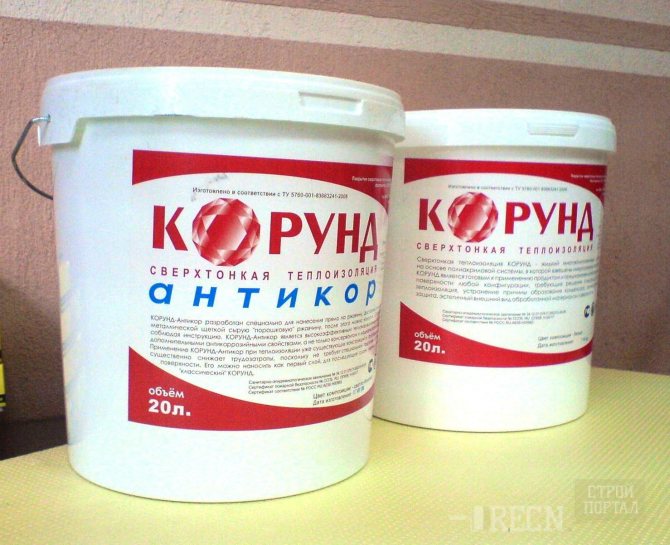

Liquid insulation. Myths and reality
Thermal insulation thickness calculator Registration of organizations on the portal Entrance for organizations to the portal. Previous topic :: Next topic.Super Corundum Regular user Registered: I certainly understand that quite a lot of arguments against liquid thermal insulation coatings are expressed on this forum, but nevertheless, they are slowly conquering the Russian market.
Good day. Homes cold walls, mold.
I don’t know about other heat-insulating paints, but Korund shows itself with dignity on serious objects.
Feedback from Likonf Lipetsk. To come back to the beginning.
Conclusion Tyumen battery plant. Cedar Kazan. Modern technologies. Zhukovsky Heating Plant Well, Elbrus CJSC is also used on the facades.
General criteria and features of choice
Ceramic thermal insulation is not yet a fairly common type of coating, due to the high cost of production. However, experts say that this substance has exceptional performance characteristics, the value of which significantly exceeds the cost of purchase. To choose the optimal type of liquid thermal insulation, it is important to take into account the following features:
- The first thing that affects the final result of ceramic insulation treatment is the density of the composition. A high-quality heat paint is characterized by an indicator of about 0.6 kg per 1 liter of product. Those. the weight of a standard 10 liter bucket should not exceed 7.5 kg.
- It is also worth looking at the container with the solution "in the light" to determine the degree of its stratification. A good indicator of the quality and effectiveness of thermal insulation properties will be a dense top layer of the substance. As a rule, ceramic spheres have a light fraction that rises to the top. Thus, the thicker the top layer, the higher the thermal insulation properties.
- An equally important selection criterion is the structure of the suspension itself. To determine it, you need to grind a couple of drops of warm paint between your fingers. The qualitative composition contains microgranules of ceramic balls, i.e. the substance has a roughness.
- In addition, it is necessary to take into account the color of the liquid insulation. Corundum is produced in white, so a gray or yellow paint is a clear evidence of product counterfeiting.
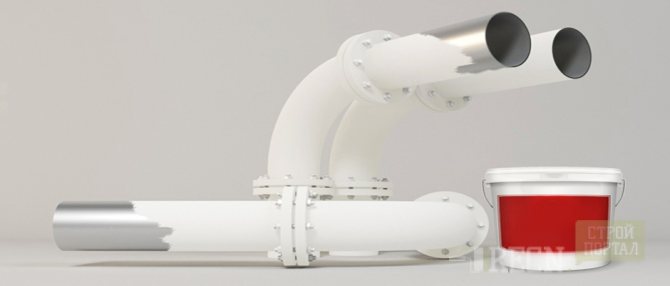

Criteria for choosing insulation Korund
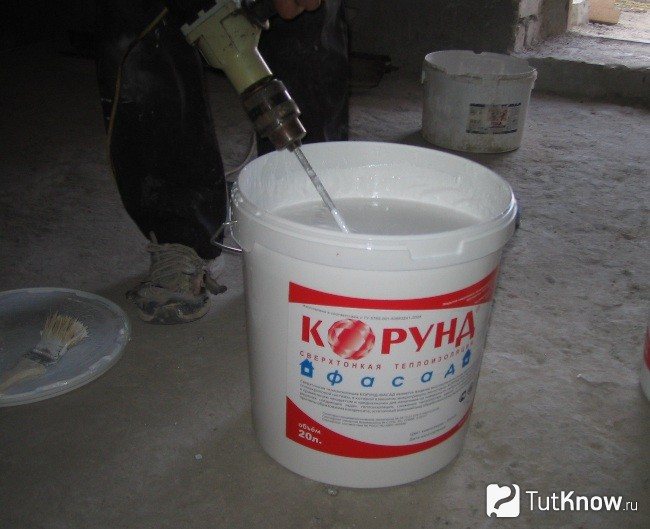

The rights to the Korund trademark belong to Fulleren NPO in Russia. The company also has a number of official distributors, for example, TeploTrade LLC, ServisInvestProekt CJSC, Torgovy Dom Korund YuFO LLC and others. Never buy from dubious sellers.
The optimal state of insulation Corundum is a paste-like suspension of white color. Standard packaging - plastic buckets of different sizes. The packaging must contain information about the manufacturer.
The price of Korund thermal insulation may differ depending on the type of material and the place of sale. On average in Russia, the cost of liquid ceramic insulation is as follows:
- Corundum Classic - 375 rubles per 1 liter;
- Corundum Antikor - 435 rubles per liter;
- Corundum Winter - 540 rubles per liter;
- Corundum Facade - 400 rubles per 1 liter.
Application area
Ultra-thin ceramic insulation Corundum is an innovative material that forms a durable elastic coating that reliably protects the surface from moisture, overheating and corrosion. This compound is used over a temperature range of -65 ° C to + 260 ° C.
The main areas of application of heat paint include:
- housing and communal services facilities (including processing of pipelines for various purposes, thermal insulation of facades, roofs, windows, walls);
- transport industry;
- oil industry;
- insulation of heat and power structures;
- construction industry.
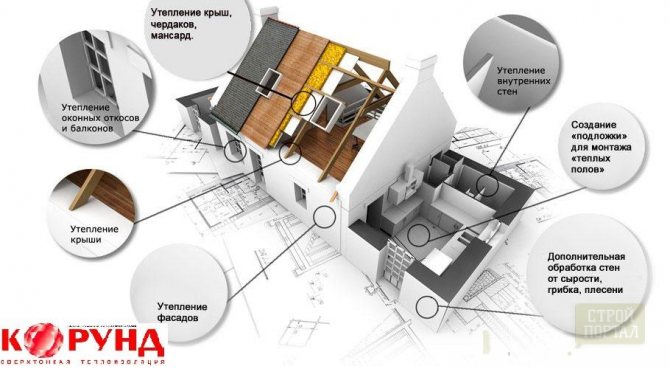

Scope of application
Heat paints have a fairly wide range of applications. They can be used both for insulating facades and applied for interior decoration of premises and thermal insulation of basements. Application to pipes, water pipes, gas pipelines and heating boilers significantly reduces heat loss.
Paints can be used to process various containers, metal structures, they are used to insulate cars. Effective in agricultural and industrial production.
Due to the wide scope of use, heat-insulating paints may well become an alternative to standard insulation.
Ceramic insulation technology
It is necessary to apply Korund ultra-thin thermal insulation on a previously prepared surface, regardless of the modification of the composition. The basic rules that should be followed before starting paint insulation include the following:
- If ceramic insulation is intended for wall treatment, the work surface should be cleaned of dust and dirt, and the existing gaps and chips should be expanded and filled with cement mortar.
- Before carrying out paint thermal insulation on concrete slabs, they should be cleaned of "cement milk".
- It is also necessary to process the wall with an abrasive wheel, sandblasting machine or a stiff metal brush.
- If you plan to treat a metal surface, it must be dedusted and degreased (the substances recommended by the manufacturer are Solv-Ur, Solvent). To paint objects made of non-ferrous metal, it is necessary to remove the gloss and apply a primer composition VL-02 or VL-023.
- It is also worth considering that it is necessary to dilute the ceramic heat paint immediately before applying it to the wall.
Important! It is recommended to mix the liquid thermal paint Korund manually. However, for work with large volumes, it is allowed to use a construction mixer, the speed of which should not exceed 200 rpm. Otherwise, there is a risk of destruction of the hollow ceramic granules, which will negatively affect the thermal insulation properties of the composition. Typically, manual mixing takes 10-15 minutes. When working with a construction mixer, this figure will be 3-7 minutes.
It is also worth considering that it is necessary to add water to some modifications of the composition before starting work, so you need to carefully study the manufacturer's instructions. The volume of liquid depends on the purpose of the thermal insulation; in any case, the required proportions are indicated on the packaging of the composition.
The technique of applying ultra-thin thermal insulation Korund is carried out in three ways:
- using air spraying devices;
- by airless spraying;
- manually - with a roller or brush.
The manufacturer recommends applying the composition in three layers, while the consumption should be 1 m / m2. When working on thermal insulation with this composition, an additional flow of ventilation in the room is not required, as well as the use of special personal protective equipment.
To guarantee the effectiveness of the result, it is important to strictly follow the manufacturer's instructions and fully adhere to the recommendations indicated on the package.


Varieties of materials KORUND
Thermal insulation products of the KORUND company have several varieties:
- KORUND ANTIKOR
A versatile material that can be applied directly to rusty surfaces. Before applying, it is enough just to walk on the surface with a regular metal brush to remove the dry layer of rust.
The insulation has an additional anti-corrosion property. This significantly reduces the cost of preparing the treated surfaces.
- KORUND CLASSIC
The heat insulator is an ultra-thin material with good thermal performance. During transportation, the liquid composition of the insulation is practically divided into fractions.
- KORUND FASAD
This type of material is applied in layers (thickness from 1 mm), so it subsequently looks like high-quality facade paint. FACADE heat-insulating paint has only positive reviews from buyers.This ultra thin liquid heat insulator is used for concrete surfaces.
FASAD paint also received excellent reviews in combination with ANTIKOR paint.
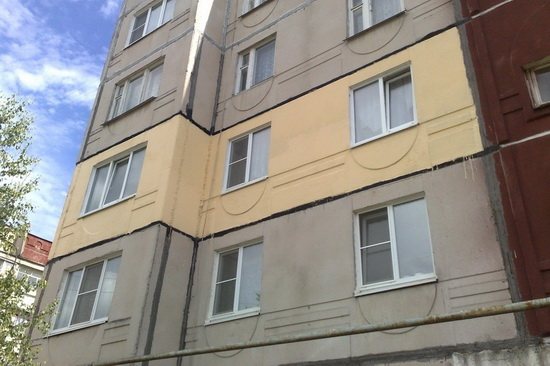

Corundum - thermal insulation from Russian scientists
Corundum - heat paint developed by Russian specialists and a new word in thermal insulation of any surfaces. Some types of this paint work even at temperatures over 500 degrees. And all because the material is not flammable. Easy to apply, Korund is thermal insulation that lasts for a long time, from 15 years, and replaces an additional wall of one and a half bricks in terms of heat conservation. Tepokraska is a unique development that imparts protective properties to the walls of buildings, facades, and concrete slabs. By using corundum paint, you save money on thermal insulation.
By its composition, it is a suspension, on a water or varnish base, which covers various surfaces well, even with irregularities. The consistency of the paint is pasty, the color is gray or white. It is convenient to work with a brush, roller or spray. The thicker the heat paint, the higher the heat protection will be. Its service life is from 15 to 40 years.
Liquid ultra-thin thermal insulation paint "Korund"
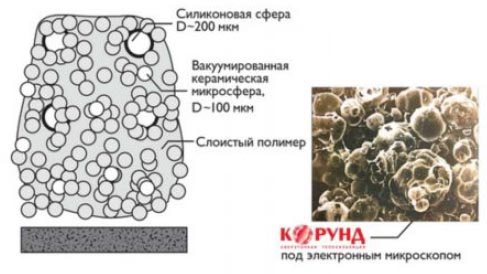

In liquid form, the "Corundum" coating is a thick composition based on artificial rubber and acrylic polymers, which contains vacuumized glass microspheres and silicone particles. The paint is applied using traditional techniques: brush or airless spray. After application to the surface, the water contained in the coating evaporates and the process of polymerization of the layer of heat-insulating paint occurs, during which cocoons of vacuumized microspheres are formed around the silicone microspheres.
Thus, the microspheres form a stable framework of the ultrathin nano-coating Corundum, which forms the basis for the thinnest longitudinal polymer films separated by microgaps. The resulting layered structure is a multilayer heat-reflecting labyrinth coating that prevents heat transfer.

